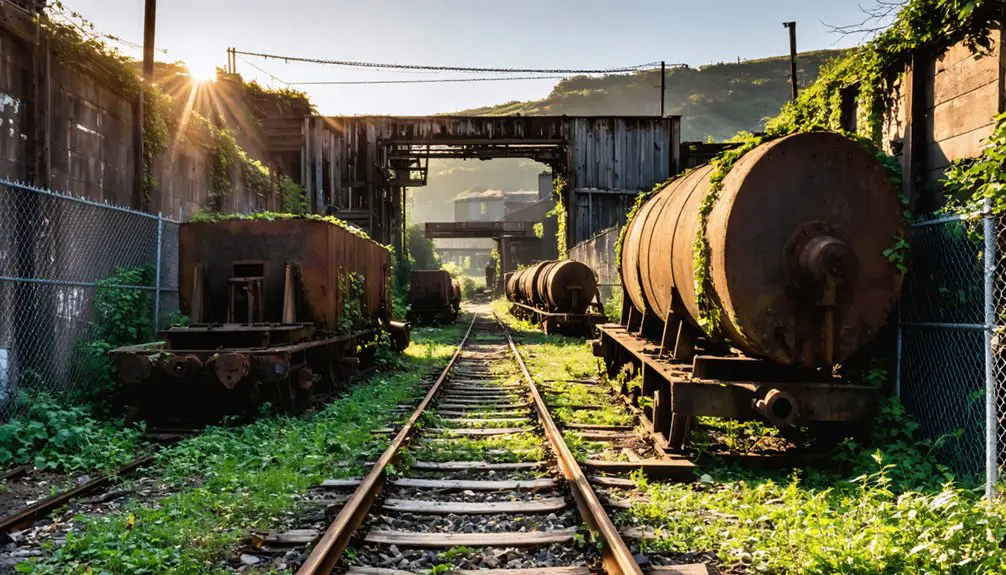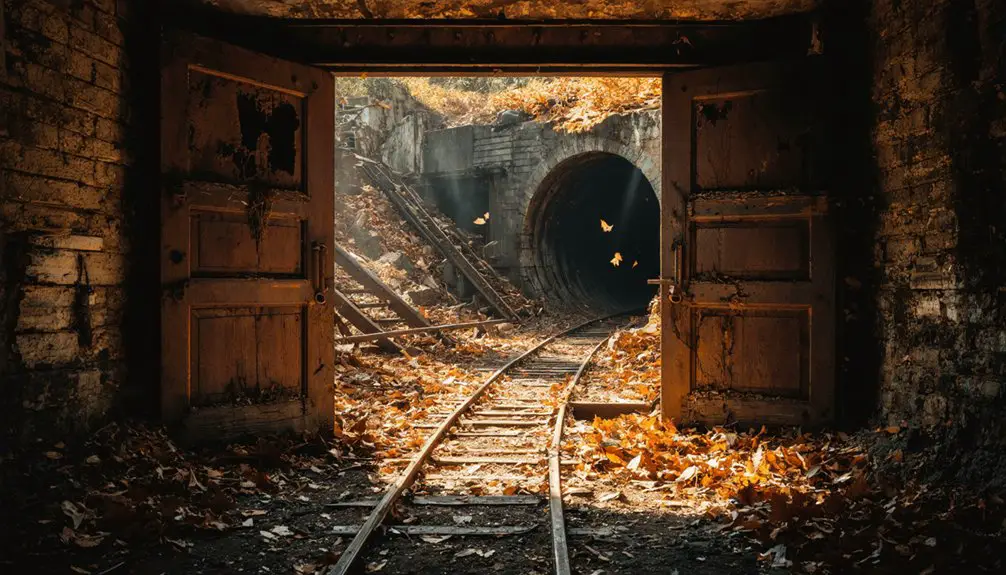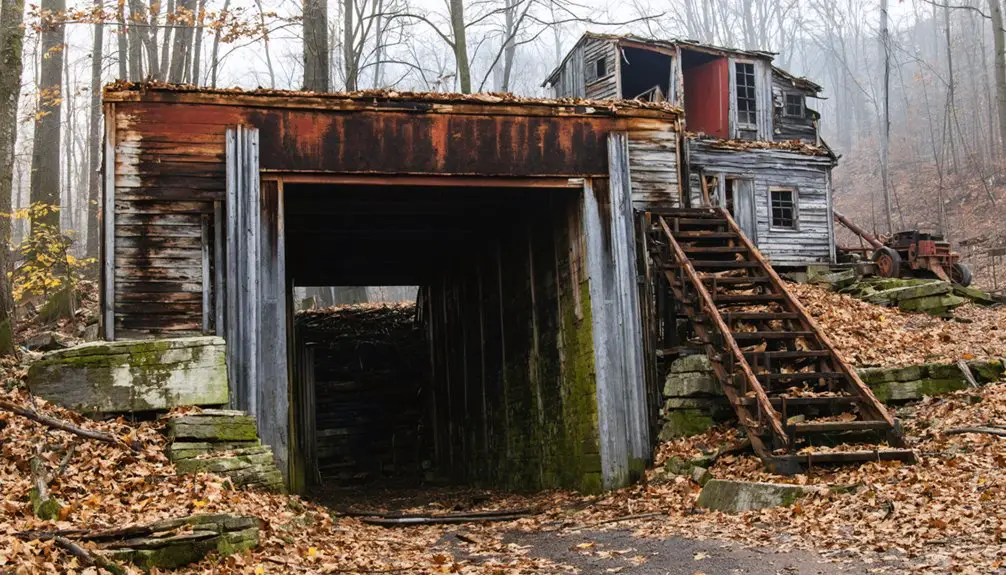You’ll discover Gold Mine’s stone foundations and sealed mine entrances nestled in Pennsylvania’s northern hills, where a once-thriving 19th-century mining town now stands frozen in time. The abandoned settlement features weathered remnants of wooden frame houses, coal breakers, and railroad beds that supported up to 60 families during its peak. Three main access points lead you through this historic ghost town, though unstable terrain requires caution. A deeper exploration reveals the fascinating story of boom-to-bust mining heritage.
Key Takeaways
- Gold Mine was a thriving Pennsylvania mining community that extracted gold, silver, lead, and copper through sophisticated underground operations.
- The town featured roughly 60 wooden houses clustered together, housing mining families who formed a tight-knit frontier community.
- The Dauphin and Susquehanna Railroad’s construction in 1846-1847 transformed Gold Mine into a crucial transportation hub.
- Economic decline occurred due to depleted resources, outdated technology, labor disputes, and devastating forest fires.
- The ghost town remains accessible via Gold Mine Road, historic stagecoach route, and Old Mine Road, featuring sealed mines and ruins.
The Rise of a Mining Frontier
While Pennsylvania’s mining legacy is often associated with coal, the state’s mining frontier emerged through diverse mineral discoveries, including significant gold deposits found in the northern counties and Lebanon County’s iron mines.
You’ll find evidence of early mining techniques in the streams and rivers where prospectors first discovered placer gold deposits carried south by glaciers from Canada.
As mining operations expanded, you’ll notice how resource management evolved from simple surface diggings to more complex underground tunneling.
The development paralleled the growth of Pittsburgh’s industrial might, with the late 1700s marking the beginning of organized mining ventures. The city’s rapid industrial growth led to consuming over 400 tons daily of bituminous coal by 1830.
Labor unions formed to protect miners and demand safer working conditions in the dangerous underground mines.
The Susquehanna River and its tributaries became focal points for gold exploration, while the emergence of mining towns transformed the landscape into bustling centers of commerce and opportunity.
Daily Life in Gold Mine’s Heyday
During Gold Mine’s peak years, you’d find mining families living in simple board and stone houses, with workers spending long days laboring in the coal mines while their children likely played near the railroad tracks and mine entrances.
The company store and mining camp served as the heart of social activity, where families would gather to purchase supplies and exchange news about working conditions, wages, and community happenings. Like many towns in Western Pennsylvania, Gold Mine exemplified the coal industry’s dominance in the region during the late 19th century.
After exhausting shifts underground, miners would return to their modest homes, which despite their utilitarian nature, provided shelter and a sense of community in this frontier boomtown. The presence of waste rock piles near homes served as a constant reminder of the mining operations that sustained the town.
Mining Family Social Life
Life in Gold Mine revolved around tight-knit social bonds that formed the backbone of this Pennsylvania mining community.
You’d find families gathering at the company store or local tavern, where informal leaders helped settle disputes and plan community gatherings. While men worked long shifts in the mines, women managed households and children helped with small tasks between school lessons.
Despite limited leisure time, you’d experience a rich social life centered around dances, music performances, and storytelling sessions.
Family roles were clearly defined, but everyone pulled together during tough times – whether facing mine accidents, economic uncertainty, or labor disputes. The mining community strike of 200 workers highlighted how families united to demand better wages and working conditions.
The church served as both a spiritual center and social hub, while sporting events and physical games provided much-needed relief from the demanding mining lifestyle. The community’s peak prosperity in the late 1800s saw the town bustling with fourteen schools, multiple theaters, and hotels where families would socialize.
Housing and Living Conditions
The stark wooden frame houses of Gold Mine stood as evidence to the practical needs of mining life, where families made do with basic accommodations that reflected their economic circumstances.
You’d find about 60 dwellings clustered tightly together, each home a representation of frontier resilience despite challenging living conditions.
The presence of scattered glass and china among the ruins today hints at the modest domestic lives these mining families once led.
Inside these modest structures, you’d navigate cramped quarters where entire families shared one or two rooms for sleeping, cooking, and socializing.
Housing materials were simple – wooden frames with minimal insulation and stone foundations.
Coal stoves served dual purposes for warmth and meal preparation, while sanitation challenges persisted with shared outdoor privies and questionable water sources.
The constant presence of mining dust and noise meant you’d spend considerable time maintaining your living space, making cleanliness an ongoing battle in these austere homes.
Work and Leisure Activities
As coal extraction drove Gold Mine’s daily rhythm, you’d find hundreds of workers descending into hazardous mine shafts for grueling shifts that often stretched from dawn to dusk.
The intense work culture centered around the railroad’s constant movement of coal, with miners fighting for fair wages and accurate tonnage credits. The town thrived until underground fire spread through the mines, forever changing the landscape.
During precious moments away from the mines, you’d gather at community spots where the work-weary spirit found refuge:
- Around weathered company store porches, sharing tales of close calls underground
- Near the water towers, where informal trade and conversation flowed freely
- At makeshift social spaces between camp buildings, where you’d find brief escape from mining’s demands
Even after official operations ceased, determined locals maintained their independent spirit through bootleg mining, keeping Gold Mine’s work-driven identity alive.
Railroad’s Role in Town Development
During the mid-1800s, Gold Mine’s establishment and growth became inextricably linked to railroad development, particularly after the Dauphin and Susquehanna Railroad’s construction in 1846-1847.
This railroad expansion transformed Gold Mine from an isolated mining settlement into a crucial transportation hub, connecting the town’s coal operations to distant markets.
You’ll find evidence of how the railroad shaped Gold Mine’s layout, as tracks were strategically placed along valleys and riverbanks to minimize grades, similar to how the Horseshoe Curve helped limit grades in other parts of Pennsylvania.
The transportation infrastructure included specialized features like loading points and complex rope haulage systems, maximizing coal shipment efficiency. The early rail systems utilized wooden rails and horse-drawn cars until technological advancements arrived.
Innovative loading facilities and rope-driven transport networks streamlined coal movement, setting new standards for mining logistics efficiency.
By 1849, steam locomotives replaced animal power, revolutionizing the town’s shipping capabilities.
The railroad’s presence attracted ancillary industries and workers, spurring the development of community infrastructure and establishing Gold Mine as a thriving coal town.
Mining Operations and Economic Impact

Mining operations in Gold Mine, Pennsylvania, centered on extracting precious metals from quartz veins formed by hydrothermal processes deep within the bedrock.
You’ll find that mining techniques evolved from simple panning to sophisticated underground operations, with multiple mine levels connected by adits for efficient ore removal.
The town’s economic prosperity rode the waves of metal market fluctuations, producing up to 7,000 tons of ore during peak years.
Here’s what made this mining town remarkable:
- Deep shaft mines that pierced the earth’s secrets, yielding gold alongside valuable silver, lead, and copper
- Massive 200-foot thickener tanks that processed ore into pure treasure
- A complex network of underground tunnels where miners risked everything for fortune
These operations sustained the local economy until resource depletion and falling metal prices ultimately sealed the town’s fate.
The Path to Abandonment
While Gold Mine once thrived with bustling industrial activity, a perfect storm of economic and operational challenges ultimately led to its downfall.
You’ll find that major economic shifts in the late 19th century, coupled with depleted coal seams and outdated technology, made mining operations increasingly unprofitable. Labor disputes and strikes further disrupted the town’s productivity, while devastating forest fires damaged essential infrastructure.
As the mines ceased operations, you can trace the community decline through rapid depopulation and deteriorating services.
Railroad companies actively demolished houses to prevent squatters from settling in, while the lack of alternative employment drove remaining residents away.
Today, nature has reclaimed much of Gold Mine’s footprint, with collapsed mine entrances and abandoned railroad beds serving as silent reminders of its industrial past.
Exploring the Ghost Town Today

Three main access points allow visitors to explore Gold Mine’s haunting remnants today. You’ll find the site accessible via Gold Mine Road, the historic stagecoach route, and Old Mine Road, each offering unique perspectives for urban exploration.
Venture into Gold Mine’s atmospheric ruins through three gateways – each path revealing a different view into Pennsylvania’s industrial past.
While venturing through this preserved slice of Pennsylvania’s mining heritage, you’ll encounter:
- Weathered stonework at sealed mine entrances, telling tales of underground pursuits
- Scattered foundations and coal breaker remains along abandoned railroad beds
- Historic water towers and bridge structures, now slowly reclaimed by nature
Historical preservation efforts protect these treasures, but you’ll need to watch your step. The terrain’s unstable from past mining operations, with hidden depressions and collapse zones.
Bring your camera and adventurous spirit, but stick to marked paths – there aren’t any visitor facilities here, and safety should be your priority.
Frequently Asked Questions
Were Any Notable Crimes or Murders Reported in Gold Mine During Its Operation?
You won’t find documented crime reports or unsolved mysteries from Gold Mine’s operational period. While labor disputes occurred, historical records don’t show any notable murders or major criminal incidents in this mining settlement.
What Happened to the Mining Equipment After the Town Was Abandoned?
Like an old iPhone left to rust, mining equipment faced swift abandonment effects – you’d find excavators, haul trucks, and bulldozers deteriorating on-site, with some parts salvaged by locals and scrappers.
Did Native Americans Have Any Settlements in the Area Before Mining?
You’ll find evidence of Native American historical settlements in this area, where Lenape and Susquehannock tribes established communities along waterways before mining began, following their traditional semi-nomadic patterns.
Were There Any Successful Gold Strikes That Made Miners Wealthy?
You won’t find any rags-to-riches stories here – Pennsylvania’s gold rush was more myth than miracle. Historical records show no miners struck it rich, with most ventures ending in disappointment and fraud claims.
Did Any Supernatural or Paranormal Activities Get Reported in Gold Mine?
You won’t find documented ghost sightings or paranormal encounters here. Despite its eerie abandoned mines and ruins, there’s no credible evidence of supernatural activity in historical records or modern reports.
References
- https://www.summitdaily.com/news/chihuahua-colorado-ghost-town-summit-county-mining-history-peru-creek/
- https://www.youtube.com/watch?v=9uziigS9lXo
- https://www.thetravel.com/ghost-towns-that-people-still-live-in/
- https://www.roadunraveled.com/blog/centralia-modern-day-ghost-town/
- https://en.wikipedia.org/wiki/List_of_ghost_towns_in_Pennsylvania
- https://www.pa.gov/agencies/dep/programs-and-services/mining/bureau-of-mining-programs/pa-mining-history.html
- https://www.identecsolutions.com/news/mining-in-us-70-centuries-of-history
- https://westernmininghistory.com/mine-detail/10108421/
- https://hsp.org/blogs/hidden-histories/mines-mysterious-discoveries-and-miracles
- https://www.historicalsociety.com/gold-window-to-history/



